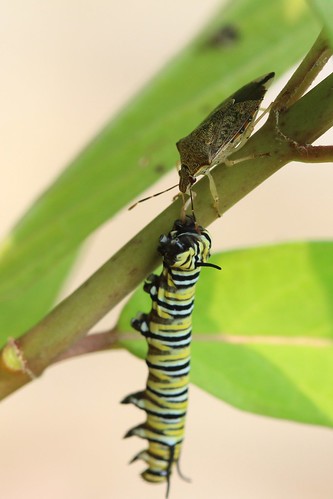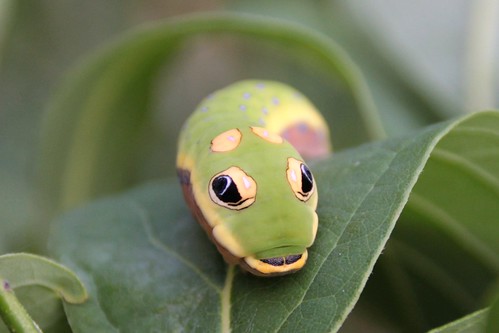Caterpillars are very good at two things. One is their near-miraculous ability to turn to goo inside a cocoon or chrysalis and emerge as a flying moth or butterfly days, weeks, or months later. The other thing is their amazing ability to quickly turn plants into protein.
Think of caterpillars as the cows of the natural world. They eat massive amounts of leaves that they quickly turn into the flesh of their bodies. If a baby human grew as fast as a Monarch Caterpillar, it would be the size of a school bus in two weeks.

It’s not hard to find animals that want to take advantage of all that caterpillar protein to have as a snack or feed to their young. Most songbirds feed their babies a steady diet of insects, especially caterpillars. One notable study by researcher Doug Tallamy found that one chickadee family fed their babies 350 to 570 caterpillars every day. That’s 6,000 to 9,000 caterpillars to raise one family of baby birds. Caterpillars, and the plants they eat, are one of the essential foundations of animal life.
Many, many insects eat caterpillars as well. Wasps fly down and eat them. One of my favorite wasps, the Potter Wasp, creates little clay pots that it fills with an egg and paralyzed caterpillars that the baby can eat when it hatches. The half-inch-wide clay pots are hidden on garden plants, rocks, and trees where most people aren’t looking. Bugs also suck the juices out of the caterpillar, leaving behind a skin that looks like a deflated balloon. Ants tear them apart and eat them.
Sometimes it is hard to believe that caterpillars ever grow up to be moths and butterflies, since they are eaten by so many things. There are many ways caterpillars can keep themselves safe. Some use ingenious camouflage and look exactly like a twig or blend into the leaves. Others pretend to be snakes and have colors that help them look like tiny snakes. Many caterpillars eat foods that make them taste horrible to some predators.
Monarch caterpillars, for example, famously only eat milkweed. This plant is full of toxic cardiac glycosides that the caterpillar incorporates into its body. These chemicals make any animal that has a backbone sick when they eat the Monarch. The caterpillars get the poisons to keep themselves safe from the plant they eat. This poison doesn’t work on invertebrates, so the caterpillars are still eaten by ants, spiders, bugs, and wasps. Research has shown that less than two out of ten Monarchs make it to the adult butterfly stage, even with all the defenses they have against birds, frogs, and other animals with spines.
Some caterpillars keep animals away with sharp spines or irritating hairs. The Io moth caterpillar has sharp spines to inject a venom into its predators that feels like a bee sting. This strategy is used by several caterpillars in the area, though there are very few caterpillars that do this. I wouldn’t hesitate to let my own children pick up and look at any caterpillar in the area.
There are over 5,000 butterflies and moths that live in the eastern half of the country. Of those, well over a thousand live in the Northeastern United States. Many of these are just as persnickety about their food as Monarchs.

Many caterpillars eat only one family of plants or one species of plant. This makes caterpillar gardening an important part of butterfly gardening. My yard is filled with plants that were planted for caterpillars in an attempt to attract butterflies. Four species of milkweed attract Monarchs. Spicebush attracts Spicebush Swallowtails. Virginia Creeper attracts Eight-spotted Foresters and a variety of moths. The violets that grow crazy under the Redbud tree provide food for Fritillaries. Most important may be the oak tree my daughter planted in the corner of the yard as an acorn. Over 500 different caterpillars dine on oak, according to biologist Douglas Tallamy.
Backyard ecosystems are important to understand. Caterpillars turn plants into the protein of their fast-growing bodies. Birds feed those caterpillars to their young, which are also growing fast. The average songbird grows from egg to flying in less than a month, a giant growth spurt mostly fueled by caterpillars and other insects.
While people say that birds feed their babies worms, it is actually a more complicated topic. Children’s books would have you believe that the worm is a segmented worm popping out of the ground with a smile, but the real worm that fuels birds is the caterpillar. Why do people call caterpillars worms? I have no idea, but have known people all my life that do so. It is the caterpillar “worms” that are important to birds much more than the earthworms. Those caterpillar worms are, remember, fussy. Perhaps we should say the early bird gets the caterpillar, instead of the early bird gets the worm.
Most butterfly and moth caterpillars will not eat trees from foreign lands. We are losing an essential part of our backyard ecosystem as we plant all of these plants from around the world. Gingkos, Bradford Pears, and Japanese Maples might look good, but they add no food for caterpillars and may reduce the number of birds and other animals that depend on those caterpillars for survival.
Caterpillars, and the plants they depend on, fuel the growth of birds and other insects. Be kind to a momma bird and plant some food for caterpillars in your yard.
Audubon Community Nature Center builds and nurtures connections between people and nature. ACNC is located just east of Route 62 between Warren and Jamestown. The trails are still open from dawn to dusk as is Liberty, the Bald Eagle. The Nature Center is partially open, including restrooms, the Blue Heron Gift Shop, and some exhibits. More information can be found online at auduboncnc.org or by calling (716) 569-2345.
Jeff Tome is a Senior Nature Educator at ACNC.


Recent Comments